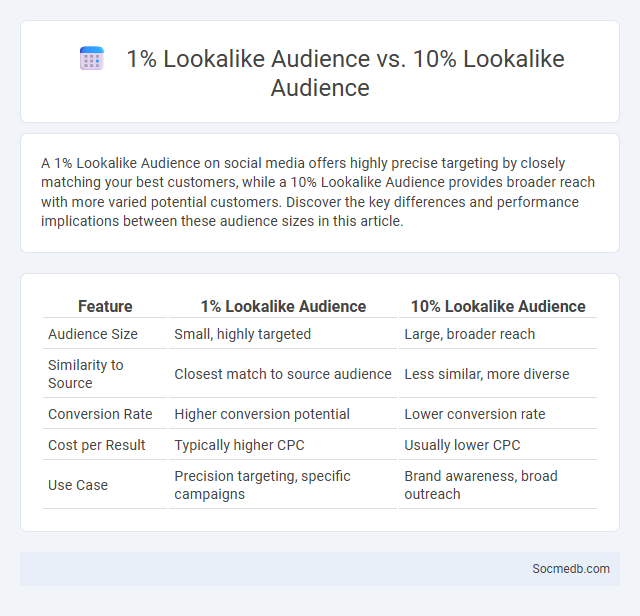
Photo illustration: 1% Lookalike Audience vs 10% Lookalike Audience
A 1% Lookalike Audience on social media offers highly precise targeting by closely matching your best customers, while a 10% Lookalike Audience provides broader reach with more varied potential customers. Discover the key differences and performance implications between these audience sizes in this article.
Table of Comparison
| Feature | 1% Lookalike Audience | 10% Lookalike Audience |
|---|---|---|
| Audience Size | Small, highly targeted | Large, broader reach |
| Similarity to Source | Closest match to source audience | Less similar, more diverse |
| Conversion Rate | Higher conversion potential | Lower conversion rate |
| Cost per Result | Typically higher CPC | Usually lower CPC |
| Use Case | Precision targeting, specific campaigns | Brand awareness, broad outreach |
Understanding Lookalike Audiences
Lookalike audiences are a powerful tool in social media marketing that allows advertisers to target new users similar to their existing customers by analyzing demographics, interests, and behavior patterns. Platforms like Facebook and Instagram use machine learning algorithms to create these audiences based on seed data from email lists, website visitors, or app users. Leveraging lookalike audiences improves ad relevance and conversion rates by reaching potential customers who share characteristics with high-value existing audiences.
What Is a 1% Lookalike Audience?
A 1% lookalike audience on social media platforms like Facebook represents the top 1% of users who share the most similarities with your existing customer base or defined source audience. This highly targeted segment increases the likelihood of engagement and conversion because it mirrors the behaviors, interests, and demographics of your most valuable users. You can leverage this precision targeting to optimize ad spend and boost campaign performance effectively.
What Is a 10% Lookalike Audience?
A 10% lookalike audience is a targeted group created by social media platforms, representing the top 10% of users most similar to your existing customer base or website visitors. This audience model uses advanced algorithms to analyze behavioral patterns, demographics, and interests, enabling Your ads to reach individuals with the highest potential to convert. Leveraging a 10% lookalike audience improves ad efficiency by narrowing focus, increasing engagement, and boosting ROI on platforms like Facebook and Instagram.
Standard Lookalike Audience Explained
Standard Lookalike Audience leverages existing customer data to identify new users with similar behaviors and interests, enhancing targeting precision on platforms like Facebook and Instagram. By analyzing source audiences as small as 100 people, the algorithm generates audiences ranging from 1% to 10% of the total population in a specific country, optimizing ad spend and conversion rates. Advertisers benefit from improved ROI by reaching individuals who resemble high-value customers, increasing the potential for engagement and sales.
Key Differences: 1% vs 10% vs Regular Lookalike Audiences
Understanding the key differences between 1%, 10%, and Regular Lookalike Audiences significantly impacts your social media advertising effectiveness. A 1% Lookalike Audience targets the top 1% of users most similar to your source, offering highly precise targeting but a smaller audience size, ideal for niche campaigns. The 10% Lookalike broadens reach with less similarity, suiting awareness goals, while Regular Lookalike Audiences balance size and similarity for steady performance in diverse campaigns.
Audience Size and Reach Comparison
Social media platforms vary significantly in audience size and reach, with Facebook boasting over 2.9 billion monthly active users, making it the largest global network. Instagram and TikTok follow closely, each attracting over 1 billion and 1 billion users respectively, offering robust engagement opportunities through visual and video content. LinkedIn targets a more professional audience with 930 million users, optimizing reach for B2B marketing and career networking.
Quality vs Quantity: Which Lookalike Delivers Better Results?
When targeting audiences on social media, quality lookalike audiences generated from highly engaged user data consistently outperform larger quantity-based lookalikes in driving conversions and engagement rates. Platforms like Facebook and Instagram emphasize the importance of precise source audience selection, as smaller, refined audiences lead to more accurate matching and higher return on ad spend (ROAS). Marketers optimizing for quality lookalikes observe improved click-through rates (CTR) and lower cost per acquisition (CPA) compared to broader quantity-driven approaches.
Cost Efficiency and ROI Analysis
Social media platforms offer cost-efficient marketing opportunities with targeted ad spend, allowing businesses to reach specific audiences without the high expenses of traditional media. Your ROI analysis can leverage detailed analytics tools to track engagement, conversions, and customer lifetime value, ensuring every dollar invested maximizes returns. By optimizing campaigns based on real-time data, you achieve better cost management and measurable growth outcomes.
When to Use 1%, 10%, or Standard Lookalike Audiences
When targeting social media ads, use 1% Lookalike Audiences to reach users most similar to your best customers, maximizing conversion rates and ROI. Employ 10% Lookalike Audiences for broader reach during brand awareness campaigns or when expanding into new markets. Standard Lookalike Audiences balance precision and scale, ideal for steady growth by targeting moderately similar users with reasonable audience size.
Best Practices for Lookalike Audience Targeting
To maximize the effectiveness of lookalike audience targeting on social media platforms, start by using high-quality source audiences with at least 1,000 to 10,000 of your best customers or converters to ensure accurate matching. Segment your source audience based on specific behaviors or demographic traits to create more precise and relevant lookalike groups, improving engagement rates and conversions. Regularly update and refresh your source data to maintain audience relevance and optimize campaign performance across channels such as Facebook, Instagram, and LinkedIn.
 socmedb.com
socmedb.com